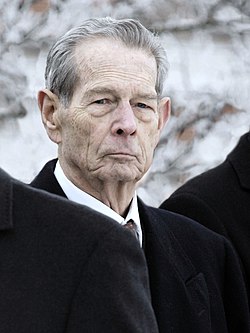Monarchism in Romania
 From Wikipedia - Reading time: 6 min
From Wikipedia - Reading time: 6 min


Romania had a monarchical form of government until its forced abolition in 1947 by occupying Soviet forces as part of the Iron Curtain.[1][2] The last king of Romania, Michael I, went into exile from 1947 onwards, culminating in his eventual rehabilitation in 1990 by former Communist officials.
However, he was expelled from the country shortly thereafter by authorities, fearing his popularity might ignite another revolution.[3]
Michael I never renounced the right to his throne, declaring shortly after his forced abdication in 1947, "The removal of the monarchy constitutes a new act of violence in the policy for the enslavement of Romania. In these conditions I do not consider myself bound in any way by this act imposed upon me."[2]
In 1992, upon his second visit to Romania since his forced abdication, he drew a crowd of 100,000 to listen to him speak from his hotel window and crowds of over a million spilled into Bucharest.[4] On Michael I's death, public polling drew support for a restored monarchy at an all-time high of 31%.[5]

Calls for monarchy
[edit]Support for the restoration of the monarchy in Romania has also been expressed by several public figures. Niculae Bădălău, the executive president of the Social Democratic Party (PSD) at the time, declared in late 2017 that despite identifying himself as a republican, he was not opposed to a referendum on the monarchy being held in Romania, saying that the issue should be discussed as "I saw that there already are many sympathizers in media".[6] In response to this, Prime Minister Mihai Tudose said that he could not support this initiative as he was not a monarchist. On the other hand, Călin Popescu-Tăriceanu, the leader of the Alliance of Liberals and Democrats (ALDE) at the time, talked about the possible benefits of having a monarch in Romania.[7]
Furthermore, Cristian Diaconescu, a former Minister of Foreign Affairs, in the face of the 2021 Romanian political crisis, declared "a constitutional monarchy would have managed the crisis better, because only it can guarantee the balance of power".[8]
Public support
[edit]The idea of the restoration of the monarchy in Romania is a popular idea that has been supported by a faction of the population ever since the Romanian Revolution. In 1997, only 7% of Romanians supported this idea, this number increased to 10% in 2002, to 14% in 2007, to 16% in 2008, to 27.2% in 2013 and to 30.2% in 2014.[9] A 2016 poll showed a decrease of support to 21%.[10] Shortly after Michael I's death, a 2018 poll showed that 37% were in favor of organizing a referendum on the monarchy.[5]
See also
[edit]References
[edit]- ^ "What happened to Romania's monarchy?". The Economist. ISSN 0013-0613. Retrieved 8 August 2023.
- ^ a b "From the archive, 5 March 1948: How Communists forced King Michael out". The Guardian. 5 March 2013. ISSN 0261-3077. Retrieved 8 August 2023.
- ^ "Expelling Former King, Romanians Cite 'Stunt' (Published 1990)". 27 December 1990. Retrieved 8 August 2023.
- ^ Williams, Carol (27 April 1992). "King Michael's Visit Stirs Joy and Unease in Romania". Los Angeles Times. Retrieved 8 August 2023.
- ^ a b Negrea, Lucian (31 January 2018). "SONDAJ - Românii spun PAS monarhiei: SURPRIZĂ în topul personalităților apreciate din Casa Regală". stiripesurse.ro (in Romanian).
- ^ Stan, Filip (18 December 2017). "Referendum pentru monarhie? Anunțul surprinzător al președintelui PSD" (in Romanian). România TV.
- ^ "Ce spun liderii PSD-ALDE despre un eventual referendum pentru monarhie". Digi24 (in Romanian). 18 December 2017.
- ^ Ghilezan, Marius (22 November 2021). "PARIS MATCH: Poate deveni România o monarhie constituțională?". România liberă (in Romanian).
- ^ Boia, Lucian (2014). "Suveranii României. Monarhia, o soluție?". Humanitas SA. ISBN 9789735046637.
- ^ Mihalache, Mădălina (26 April 2016). "Sondaj. Monarhia putea salva România. Două treimi din români cred că am fi evoluat înspre mai bine dacă după Revoluție deveneam monarhie". Adevărul (in Romanian).
 KSF
KSF